



Click on the links above for accounts and photos of these trips.
 This is the little harbour at Volendam which as a result of its completely insulated location has managed to preserve its character for six centuries. Volendam is famous for its harbour, fishing trade, authentic Dutch character and traditional clothing and I guess has to be on any trip advertised as 'The Delights of Holland'
This is the little harbour at Volendam which as a result of its completely insulated location has managed to preserve its character for six centuries. Volendam is famous for its harbour, fishing trade, authentic Dutch character and traditional clothing and I guess has to be on any trip advertised as 'The Delights of Holland'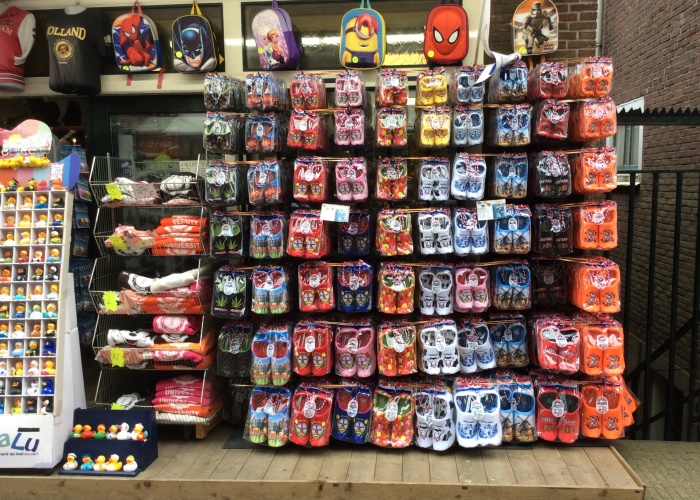 Clogs for sale.
Clogs for sale.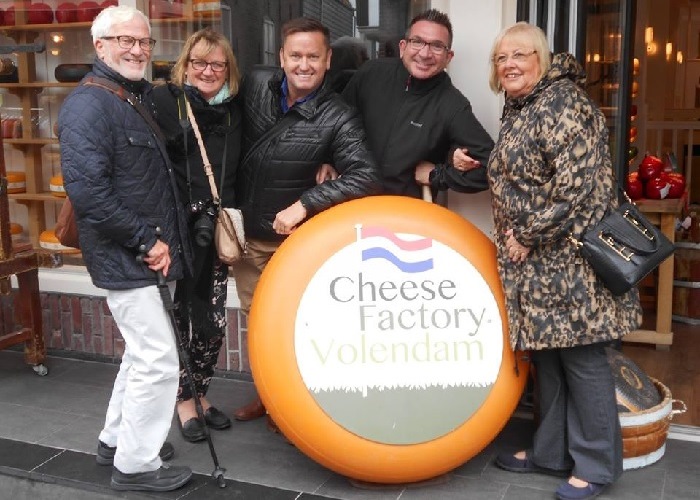 Originally, Volendam was the location of the harbor for Edam which is just to the north; in 1357, the inhabitants of Edam dug a shorter canal to the Zuiderzee with its own separate harbor but as you can see from the gang standing outside the cheese facory shop, there is still a tradition of selling Edam cheese with its instantly recognisable shape and colour.
Originally, Volendam was the location of the harbor for Edam which is just to the north; in 1357, the inhabitants of Edam dug a shorter canal to the Zuiderzee with its own separate harbor but as you can see from the gang standing outside the cheese facory shop, there is still a tradition of selling Edam cheese with its instantly recognisable shape and colour. Two Hats - brings back memories of Croatia (LOL). John took pity on the girls because they were cold and bought them a woolly hat each - he is so considerate, but I'm not sure about the pearl decorations and the pom-poms!
Two Hats - brings back memories of Croatia (LOL). John took pity on the girls because they were cold and bought them a woolly hat each - he is so considerate, but I'm not sure about the pearl decorations and the pom-poms!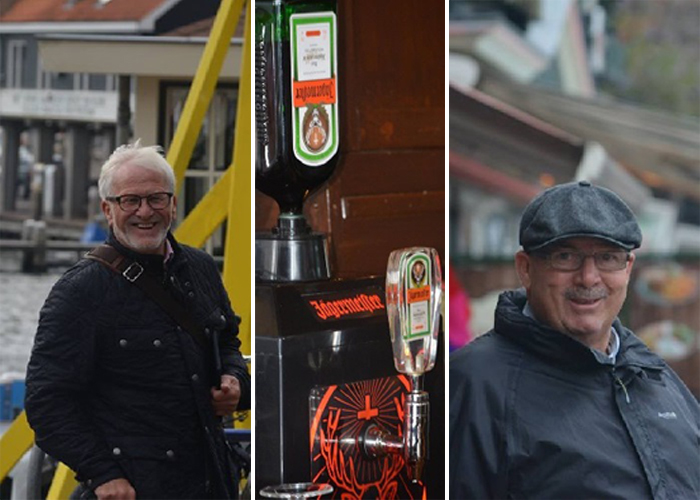 Spotted in Volendam, two reprobates and Jagermeister on tap (LOL).
Spotted in Volendam, two reprobates and Jagermeister on tap (LOL). This painting of men playing cards is by an unknown artist but in the early part of the 20th century it became something of an artists' retreat, with both Picasso and Renoir spending time here, and many artists paid their bills with paintings instead of money which they didn't have. Consequently there are many paintings in hotels and bars most of which have no known origin.
This painting of men playing cards is by an unknown artist but in the early part of the 20th century it became something of an artists' retreat, with both Picasso and Renoir spending time here, and many artists paid their bills with paintings instead of money which they didn't have. Consequently there are many paintings in hotels and bars most of which have no known origin. 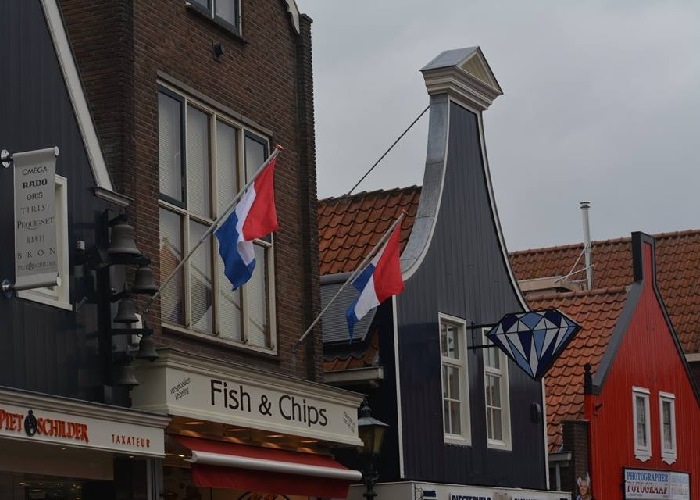 The gable ends of the buildings is typical 'old' Dutch but I'm not sure when they imported the 'Fish and Chips' tradition; I guess we see this as an 'old' English tradition.
The gable ends of the buildings is typical 'old' Dutch but I'm not sure when they imported the 'Fish and Chips' tradition; I guess we see this as an 'old' English tradition. From Volendam we went on to Hoorn; an interesting fact is that Cape Horn was named after this town by the Dutch navigator Willem Schouten who was born here and, in 1616, was the first to sail this route to the Pacific Ocean. This photo is of the small harbour which is now used by small fishing boats. Hoorn was an important home base for the Dutch East India Company and a very prosperous centre of trade in its Golden Age during the 17th century.
From Volendam we went on to Hoorn; an interesting fact is that Cape Horn was named after this town by the Dutch navigator Willem Schouten who was born here and, in 1616, was the first to sail this route to the Pacific Ocean. This photo is of the small harbour which is now used by small fishing boats. Hoorn was an important home base for the Dutch East India Company and a very prosperous centre of trade in its Golden Age during the 17th century.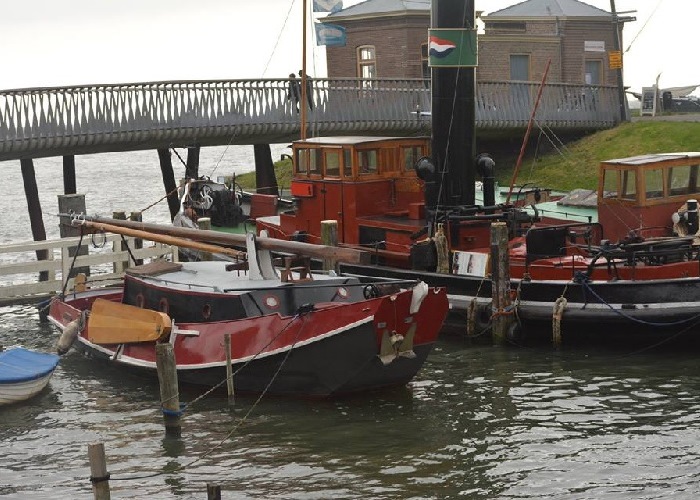 Small fishing boats at Hoorn.
Small fishing boats at Hoorn. A 'starling' fishing for food from the table (in Volendam), a heron fishing for fish in the marina (at Hoorn) and a boat waiting for a fisherman (seen in the marina at Hoorn) - John has a good eye for a photo with his new camera.
A 'starling' fishing for food from the table (in Volendam), a heron fishing for fish in the marina (at Hoorn) and a boat waiting for a fisherman (seen in the marina at Hoorn) - John has a good eye for a photo with his new camera.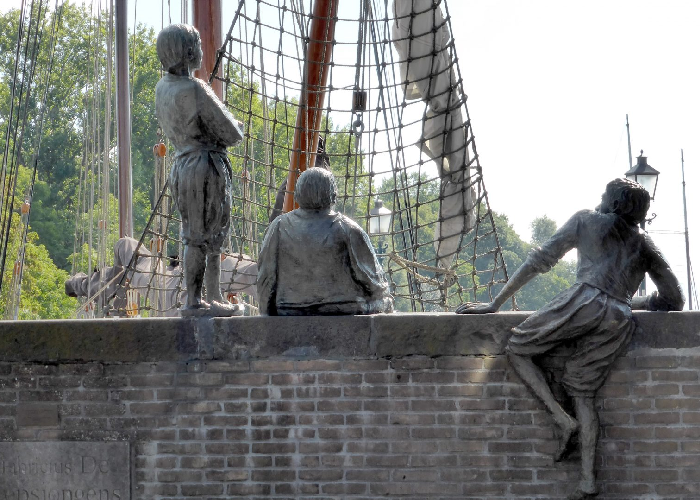 Since 1968, a trio of ship's boys (a bronze sculpture by Jan van Druten) has looked out over the harbour from the base of the tower. They represent the heroes of the journal (first published in 1646) of Dutch captain Willem Bontekoe, about three young boys, Hajo, Ralf and Padde, who sailed to the Dutch East Indies aboard his ship the Nieuw Hoorn. Due to an accident caused by Padde (dropped a candle and set fire to a cask of brandy which caused an explosion of powder kegs) the ship is wrecked, leaving the boys to fend for themselves in the East.
Since 1968, a trio of ship's boys (a bronze sculpture by Jan van Druten) has looked out over the harbour from the base of the tower. They represent the heroes of the journal (first published in 1646) of Dutch captain Willem Bontekoe, about three young boys, Hajo, Ralf and Padde, who sailed to the Dutch East Indies aboard his ship the Nieuw Hoorn. Due to an accident caused by Padde (dropped a candle and set fire to a cask of brandy which caused an explosion of powder kegs) the ship is wrecked, leaving the boys to fend for themselves in the East. The Hooftdoren is now a restaurant but was originally built in 1532 to watch over the main entrance to the harbour, this tower was topped in 1651 with a small wooden steeple; on the back of the tower is a sculpture of a unicorn, the town's symbol.
The Hooftdoren is now a restaurant but was originally built in 1532 to watch over the main entrance to the harbour, this tower was topped in 1651 with a small wooden steeple; on the back of the tower is a sculpture of a unicorn, the town's symbol. The Hooftdoren restaurant is on the first floor and to get to it you have to go up a winding staircase, similarly going to the toilet means going down the winding staircase again; probably not a good idea after a couple of bottles of wine. Food and service are reported as good.
The Hooftdoren restaurant is on the first floor and to get to it you have to go up a winding staircase, similarly going to the toilet means going down the winding staircase again; probably not a good idea after a couple of bottles of wine. Food and service are reported as good.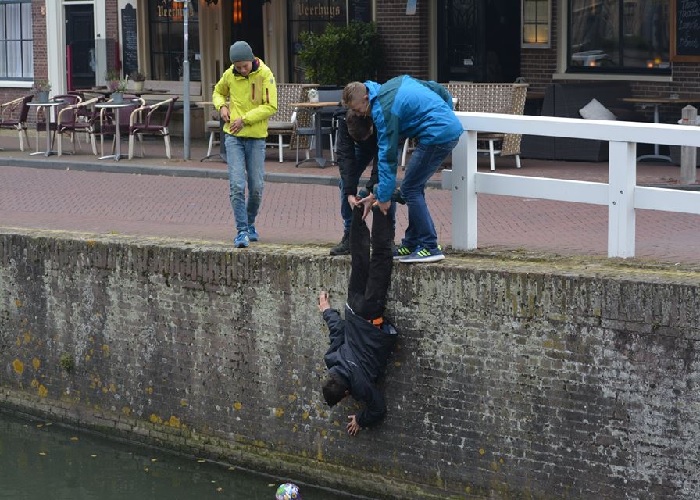 It's probably a bit uncharitable to say that we were willing these boys to let go of the lad retrieving his ball from the harbour (at Hoorn). It puts a new slant on 'please mister can I have my ball back'.
It's probably a bit uncharitable to say that we were willing these boys to let go of the lad retrieving his ball from the harbour (at Hoorn). It puts a new slant on 'please mister can I have my ball back'.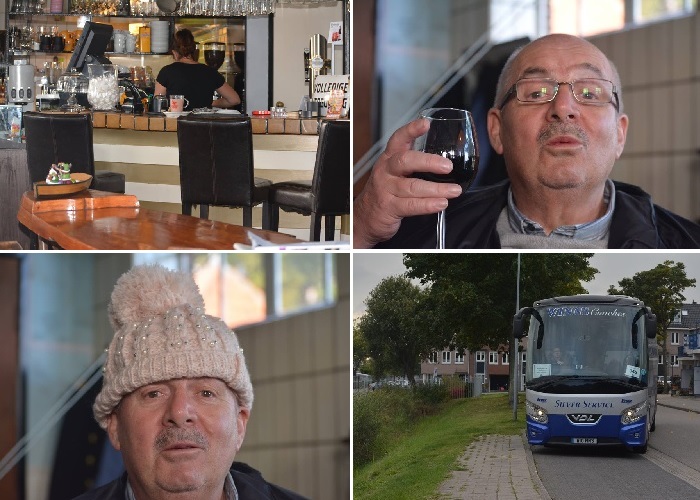 From Hoorn we carried on to Enkhuisen but to be honest by this time we were travelled out for the day and if I have any criticism it's that sometimes the places we go are to fit in with the brochure details. The drivers have no choice because the brochure says we will visit this place but most of the passengers would have been quite happy to have gone home at this stage in the day. Consequently we just went to a cafe and had a drink (alcoholic as you can see!) and a laugh (as always).
From Hoorn we carried on to Enkhuisen but to be honest by this time we were travelled out for the day and if I have any criticism it's that sometimes the places we go are to fit in with the brochure details. The drivers have no choice because the brochure says we will visit this place but most of the passengers would have been quite happy to have gone home at this stage in the day. Consequently we just went to a cafe and had a drink (alcoholic as you can see!) and a laugh (as always).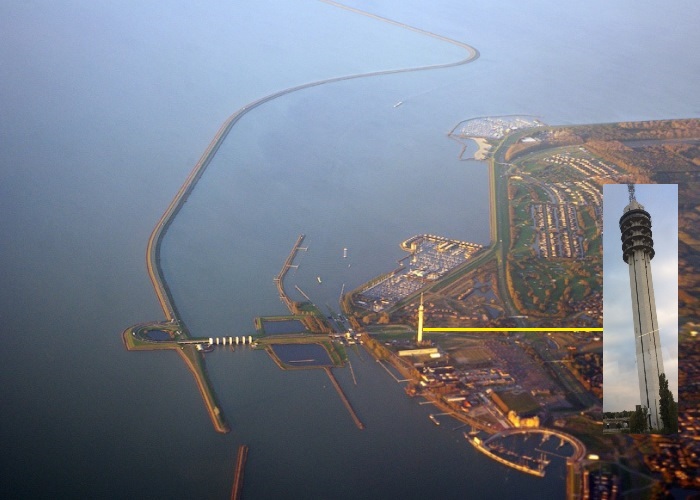 On the way back from Enkhuisen, we crossed the Zeiderzee to Lelystad (shown from above in the photo) via the 27km Houtribdijk; although we didn't get any worthwhile photos of this man made construction I thought it worth getting an image off the internet to tell you a bit about it. Sometimes referred to as a dyke because it is man made and has a road running along the middle but is in fact a dam to keep the water back and protect Amsterdam from flooding. Originally they intended to reclaim the land (a polder) on the left of the dam which was to be called the Markerwaard but is now unlikely to be constructed. At the Lelystad end is the Alticom communications tower which are dotted all over Holland.
On the way back from Enkhuisen, we crossed the Zeiderzee to Lelystad (shown from above in the photo) via the 27km Houtribdijk; although we didn't get any worthwhile photos of this man made construction I thought it worth getting an image off the internet to tell you a bit about it. Sometimes referred to as a dyke because it is man made and has a road running along the middle but is in fact a dam to keep the water back and protect Amsterdam from flooding. Originally they intended to reclaim the land (a polder) on the left of the dam which was to be called the Markerwaard but is now unlikely to be constructed. At the Lelystad end is the Alticom communications tower which are dotted all over Holland.